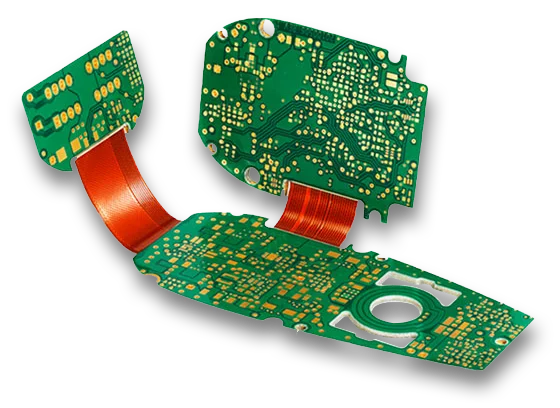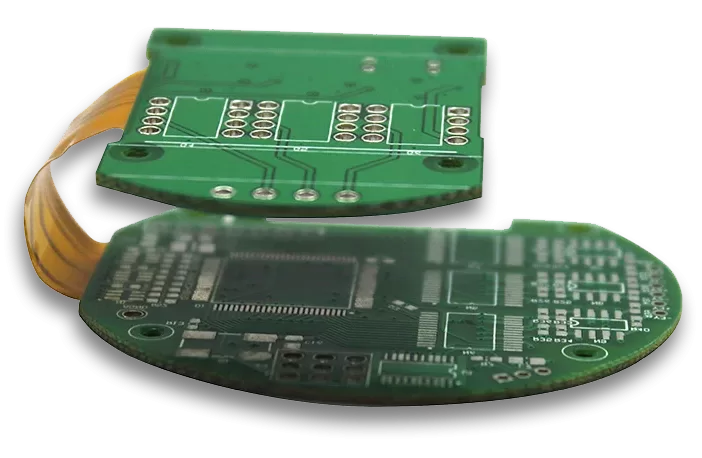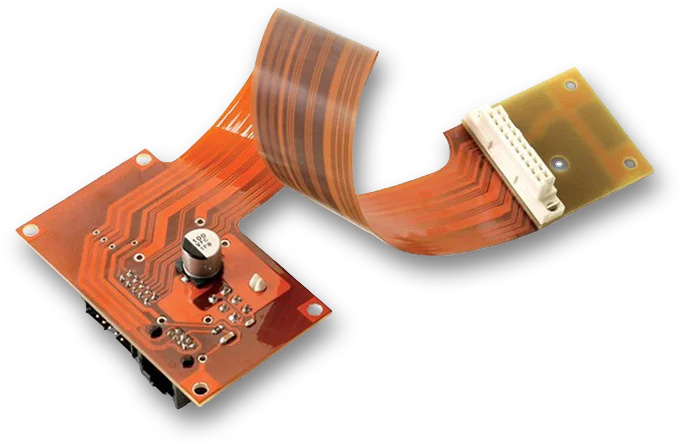Rigid-Flex PCB Design & Capabilities





Rigid-Flex PCB
Rigid-flex PCBs are a combination of both rigid and flex PCBd technology. This type of PCB powers the robustness of rigid PCB and flexibility of flexible PCB to produce a PCB that is efficient and light weight. In this unique combination the rigid and flex substrates are laminated together for greater ability to transmit signals at low loss, since the design format eliminates connection problems as it does not use connectors.
Each Rigid-Flex PCB has multiple zones of rigid and flex materials based on the design that work in sync to produce one seamless board. The common materials used in manufacturing of rigid-flex boards are FR4 for rigid part and materials like Kapton for the flex part. Usually Rigid part has more layers than the flex.
Hiberxen manufacture Rigid-flex PCBs for a wide range of industries like medical, consumer electronics, defence, lighting, communication based. Our PCB Engineers works with the customer to build the right stack up for their rigid-flex PCB.
Types of Rigid-Flex PCB
Depending on the process of joining the rigid and flex PCB parts, there are two types.
- Rigid-Flexible Composite PCB:
Combining rigid and flexible PCB parts, you will note a common blind & buried via design between two boards. This type will have a higher-density circuit design. Blind vias are those that connect two layers but do not penetrate the outer layers. Buried vias are useful for trace routing and augment circuit space by allowing different component pads to connect to each other. Rigid-flex PCBs should be designed with as few vias as possible and avoid via placement. - Rigid-Flexible Laminated PCB:
In this type rigid and flex PCB parts produced separately then laminates them together. The through-hole design doesn’t apply here. - Multi-layer Rigid-flexi PCB:
We can design and manufacture multi-layer rigid-flex PCBs with up to 8 layers in flexible part and up to 32 layers in rigid part of the PCB
- Rigid-Flexible Composite PCB:
The production process for a rigid-flex PCB is more complex, requiring more materials and manpower. However, it is worth the extra cost because rigid-flex PCBs are good in high-performance applications like TVs and medical devices. These circuit boards are also widely used in low-tech, bendable applications, such as kitchen cabinets and LED lighting. Their flexibility allows them to fit tightly into small spaces and minimize layout flaws.
Rigid-Flex PCB Capabilities
| Item | Description | Remark | |
| Layer | Flex part of PCB: 1-8Layers Rigid part of PCB: 2-32Layers | ||
| Material | PI, PET, PEN, FR-4 | ||
| Final Thickness | Flex part of PCB: 0.002″ – 0.1″(0.05-2.5mm) Rigid part of PCB: 0.008″ – 0.275″ (0.2mm- 7mm) | ||
| Surface Treatment | Lead-free: ENG Gold; OSP, Immersion silver, Immersion Tin | ||
| Max / Min Board Size | Min: 0.2″x0.3″ Max: 20.5″x13″ | ||
| Min Trace Width / Min Clearance | Inner: 0.5oz: 4/4mil 1oz: 5/5mil 2oz: 5/7mil | Outer: 1/3oz-0.5oz: 4/4mil 1oz: 5/5mil 2oz: 5/7mi | |
| Min Hole Ring | Inner: 0.5oz: 4mil 1oz: 5mil 2oz: 7mil | Outer: 1/3oz-0.5oz: 4mil 1oz: 5mil 2oz: 7mil | |
| Copper Thickness | 1/3oz – 2oz | ||
| Max / Min Insulation Thickness | 2mil/0.5mil (50um/12.7um) | ||
| Min Hole Size and Tolerance | Min hole: 8mil Tolerance: PTH±3mil, NPTH±2mil | ||
| Min Slot | 24mil x 35mil (0.6×0.9mm) | ||
| Solder Mask Alignment Tolerance | ±3mil | ||
| Silkscreen Alignment Tolerance | ±6mil | ||
| Silkscreen Line Width | 5mil | ||
| Gold Plating | Nickel: 100u” – 200u” | Gold: 1u”-4u” | |
| Immersion Nickel / Gold | Nickel: 100u” – 200u” | Gold: 1u”-5u” | |
| Immersion Silver | Silver: 6u” – 12u” | ||
| OSP | Film: 8u” – 20u” | ||
| Test Voltage | Testing Fixture: 50-300V | ||
| Profile Tolerance of Punch | Accurate mould: ±2mil | ||
| Ordinary mould: ±4mil | |||
| Knife mould: ±8mil | |||
| Hand-Cut: ±15mil | |||
We're here to help
Our team is ready for you. Feel free to contact us by e-mail or our social media, so we can learn more about you and your needs.
